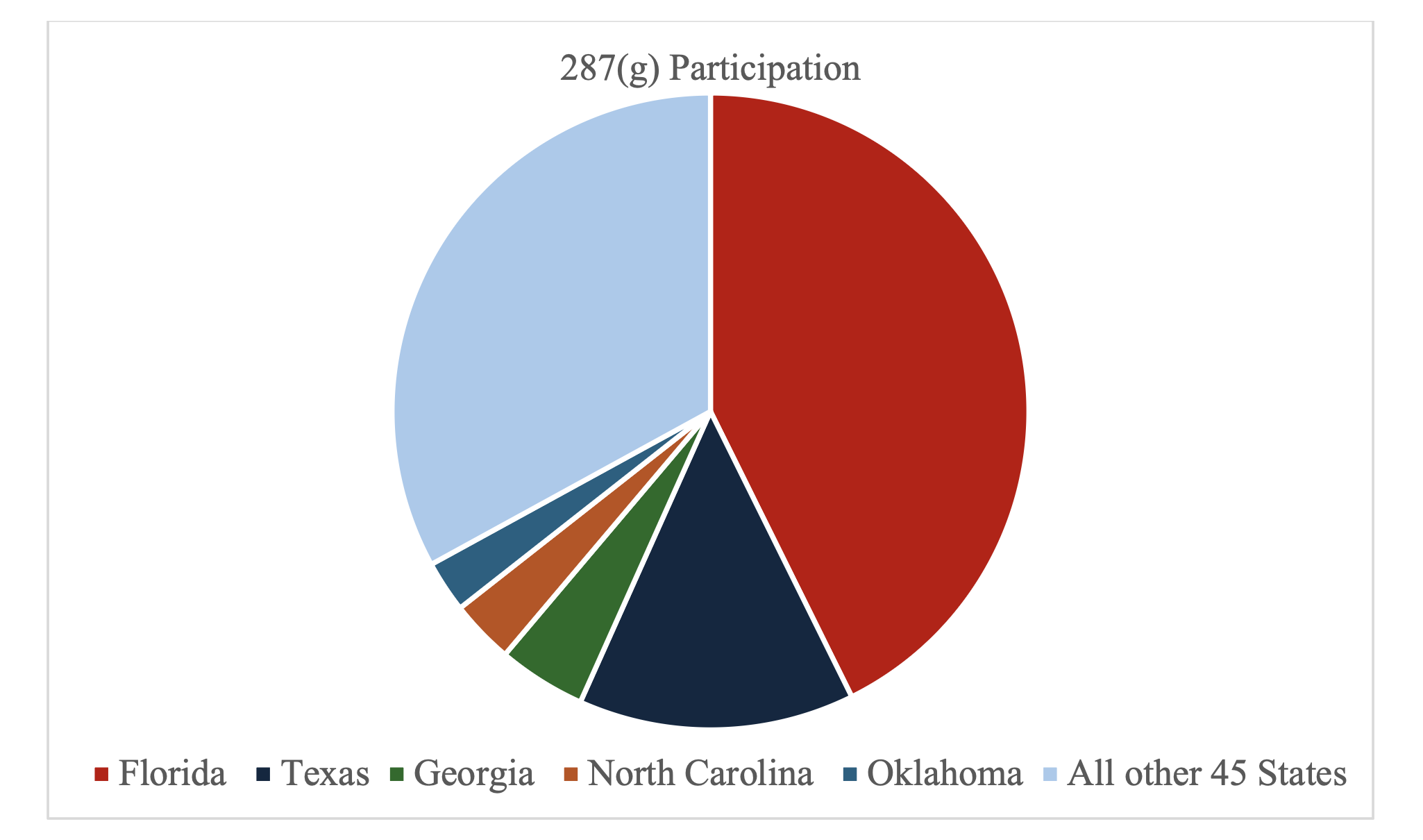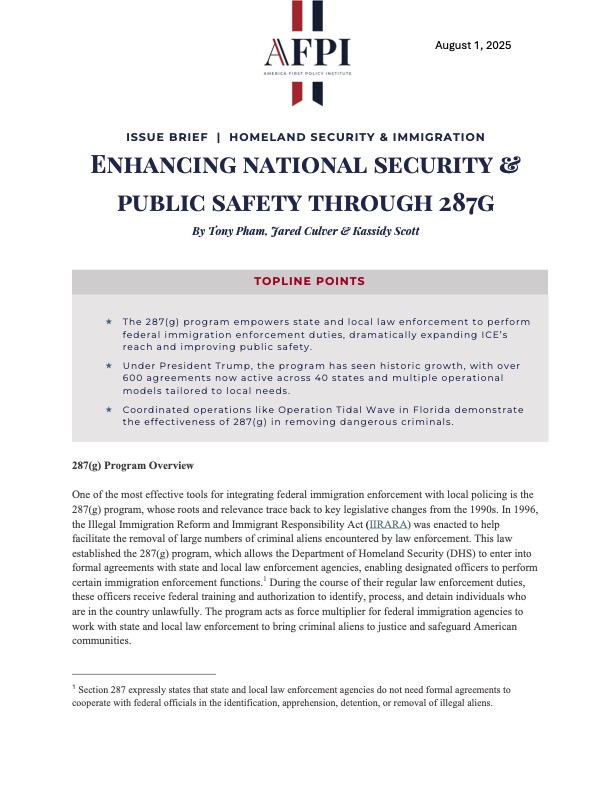Enhancing National Security & Public Safety Through 287g
Key Takeaways
« The 287(g) program empowers state and local law enforcement to perform federal immigration enforcement duties, dramatically expanding ICE’s reach and improving public safety.
« Under President Trump, the program has seen historic growth, with over 600 agreements now active across 40 states and multiple operational models tailored to local needs.
« Coordinated operations like Operation Tidal Wave in Florida demonstrate the effectiveness of 287(g) in removing dangerous criminals.
By Tony Pham, Jared Culver & Kassidy Scott
287(g) Program Overview
One of the most effective tools for integrating federal immigration enforcement with local policing is the 287(g) program, whose roots and relevance trace back to key legislative changes from the 1990s. In 1996, the Illegal Immigration Reform and Immigrant Responsibility Act (IIRARA) was enacted to help facilitate the removal of large numbers of criminal aliens encountered by law enforcement. This law established the 287(g) program, which allows the Department of Homeland Security (DHS) to enter into formal agreements with state and local law enforcement agencies, enabling designated officers to perform certain immigration enforcement functions.[1] During the course of their regular law enforcement duties, these officers receive federal training and authorization to identify, process, and detain individuals who are in the country unlawfully. The program acts as force multiplier for federal immigration agencies to work with state and local law enforcement to bring criminal aliens to justice and safeguard American communities.
Although authorized by Congress in 1996, the federal government had generally not taken advantage of the 287(g) program until President Trump took office in January of 2017. On January 25, 2017, President Trump signed Executive Order (EO) 13768, “Enhancing Public Safety in the Interior of the United States.” Section 8 of this Executive Order sought to empower and expand the use of the 287(g) program across the United States.
The first ever 287(g) partnership was signed in 2002, six years after the program’s creation, with the Florida Department of Law Enforcement. In 2009, the Obama Administration weakened the 287(g) program by placing strict requirements on state and local law enforcement agencies who were seeking to coordinate with Immigration and Customs Enforcement. By 2017, there were only thirty-five 287(g) agreements in place. When running for office, Joe Biden promised to end 287(g) expansion and terminate the program, and then during the Biden Administration, most illegal aliens in the interior were declared exempt from removal as a matter of policy and therefore outside of the reach of the 287(g) program. In fact, on January 20, 2021, President Joe Biden revoked Executive Order 13768 as one of his first actions and paused any new 287(g) agreements.
President Donald Trump understands the importance of 287(g) programs for immigration enforcement. During his first term, his administration increased the number of existing agreements from 35 in 2017 to about 150 in 2020 (GAO, 2021). On January 20, 2025, President Donald J. Trump issued Executive Order 14159, titled “Protecting the American People Against Invasion.” This EO requires ICE to authorize state and local law enforcement officials to assist federal enforcement of immigration laws (as the DHS Secretary determines are qualified and appropriate) under section 287(g) of the Immigration and Nationality Act to the maximum extent permitted by law. Similar EOs were issued in 2017: Executive Order Nos. 13767 and 13768.
Path Forward for 287(g)
The sheer participation in the 287(g) program in President Trump’s first six months in office dwarf the previous administration’s use of a valuable immigration enforcement program. The 287(g) programs provide various agreements agencies can participate in, including the Jail Enforcement Model (JEM), Warrant Service Officer (WSO), and Task Force Model (TFM) agreements to enhance their work alongside immigration officers. Under President Biden, in fiscal year 2022 alone, ICE reported that there were only 65 signed JEM agreements in 19 states and 76 signed WSO agreements in 11 states. Under President Trump, as of June 11, 2025, ICE data reveals that 649 Memorandums of Agreement for 287(g) programs, covering 40 states, have been signed. These include JEM agreements with 102 law enforcement agencies in 26 states, WSO agreements with 232 law enforcement agencies in 32 states, and the TFM agreements with 315 agencies in 30 states. ICE also reports that as of June 11, 2025, there are 101 287(g) program applications pending.
These different models are defined as follows:
- Jail Enforcement Model (JEM): Designated Immigration Officers (DIOs) identify and process removable aliens who were arrested locally.
- Task Force Model (TFM): Task Force Officers (TFOs) conduct immigration enforcement with ICE oversight in non-custodial settings, such as community enforcement actions.
- Warrant Service Officer Model (WSO): DIOs execute civil warrants on behalf of ICE.
Jail Enforcement Model (JEM)
The JEM DIOs are local personnel who are assigned detention duties, can serve and execute warrants for removal, and are authorized to interview detainees, administer oaths, and consider evidence for aliens in custody. For example, a local deputy sheriff under the 287(g) JEM will have the delegated authority to interview a suspected illegal alien who is committed to the local jail under local criminal charges, such as DUI, or even egregious felonies such as rape. This interview is conducted in addition to the standard committal questioning and will cover alienage, citizenship or status and removability. The DIO is empowered to conduct a full investigation as if he or she were an ICE officer in order to determine whether the alien is in the United States illegally, thus multiplying the reach of ICE’s investigation and apprehension authority. JEM models provide power to local law enforcement to:
- Interrogate any person detained in the participating detention center.
- Serve and execute warrants of arrest for immigration violations at the time of the alien’s scheduled release from criminal custody in order to transfer the alien to ICE.
- Serve warrants of removal on designated aliens at the time of the alien’s scheduled release from criminal custody.
- Administer oaths, take and consider evidence, and complete alien intake and processing.
- Prepare charging documents, including the Notice to Appear (NTA).
- Detain and transport arrested aliens subject to removal to ICE detention.
- Issue immigration detainers.
Task Force Model (TFM)
The Task Force model expands ICE’s enforcement operations in the community by training and empowering local law enforcement officers to perform the duties of immigration enforcement in the field under the supervision of ICE. This model is focused on field operations, similar to operations conducted by ICE Enforcement Removal Operations (ERO) officers. This model is especially effective as it delegates immigration arrest authorities of illegal aliens to local law enforcement officers who are already in the community enforcing criminal statutes. Specifically, TFM provides power to local law enforcement to:
- Interrogate any alien or person believed to be an alien and to process for immigration violations those individuals who have been arrested for state or federal crimes.
- Arrest without a warrant any alien entering or attempting to unlawfully enter the U.S. if the officer has reason to believe the alien is likely to escape before a warrant can be obtained.
- Arrest without a warrant for felonies which have been committed, and which are cognizable under any law of the United States regulating the admission, exclusion, expulsion, or removal of aliens if the officer believes the aliens is likely to escape before a warrant can be obtained.
- Serve and execute warrants of arrest.
- Administer oaths, take and consider evidence, and complete processing intake for aliens.
- Prepare charging documents, including the Notice to Appear (NTA).
- Issue immigration detainers.
- Take and maintain custody of aliens arrested by ICE or other local law enforcement on behalf of ICE.
- Transport aliens to ICE detention facilites.
The Task Force model yields the broadest authority to local officials with less dependency on ICE by allowing locals to operate both within jails and prisons and in the field. With jurisdiction extending into the field, local officers can amplify the reach of ICE in addition to providing support for ICE’s ongoing enforcement actions.
Warrant Service Officer Model
Lastly, the WSO model delegates the federal authority to DIOs to only serve and execute immigration warrants on aliens who are already in local jail custody. While ICE still conducts the investigation into illegal aliens’ status, this model authorizes the local detention officer to serve the immigration warrant, which initiates the removal process. In this model, ICE trains and supervises local officers and identifies each illegal alien in their custody who is eligible for removal, thereby allowing local officials to support ICE in their existing initiatives.

As of the publication of this issue brief, Florida, Texas, Georgia, North Carolina, and Oklahoma lead the nation with the most signed 287(g) agreements. Florida alone accounts for nearly 43% of agreements signed nationwide, while Texas holds 14%, Georgia holds 4%, North Carolina 3%, and Oklahoma with 3% account for 24% combined.
Operation Tidal Wave: Clarion Call for State and Local Elected Officials
The current Trump Administration is only beginning to capitalize on the force-multiplying potential of 287(g) coordination. For example, ICE and Florida law enforcement arrested 1,120 aliens, including murderers, rapists, and gang members, in Operation Tidal Wave, which was a multi-agency immigration enforcement operation that included support from federal partners assisting ICE, along with extensive help from the state of Florida. Florida has gone as far as implementing a program that incentivizes self-deportation to expedite removals. By partnering with the Border Patrol’s Miami Sector, illegal aliens who have not committed additional crimes upon crossing the border are given the option to self-deport with a Florida-funded flight out of the U.S. It is crucial to note that much of this is possible because numerous Florida jurisdictions have signed TFM 287(g) agreements.
Together, the State of Florida and the federal government are demonstrating the potential of coordinated enforcement efforts to target and remove dangerous criminal aliens swiftly and safely. Florida Governor Ron DeSantis is not only removing criminals from the streets, but he is doing it without having to invest in long term incarceration. U.S. governors or mayors looking for concrete policy proposals to reduce crime and increase public safety need look no further than 287(g) and Operation Tidal Wave.
Conclusion
The 287(g) program stands as a proven solution for restoring immigration enforcement and public safety through constitutionally sound cooperation between federal and local authorities. As the Biden Administration oversaw crime and chaos linked to illegal immigration across the country, this program provides a scalable and effective tool to restore order. With continued expansion and support, 287(g) can empower more communities to protect their citizens and uphold the rule of law.
[1] Section 287 expressly states that state and local law enforcement agencies do not need formal agreements to cooperate with federal officials in the identification, apprehension, detention, or removal of illegal aliens.
